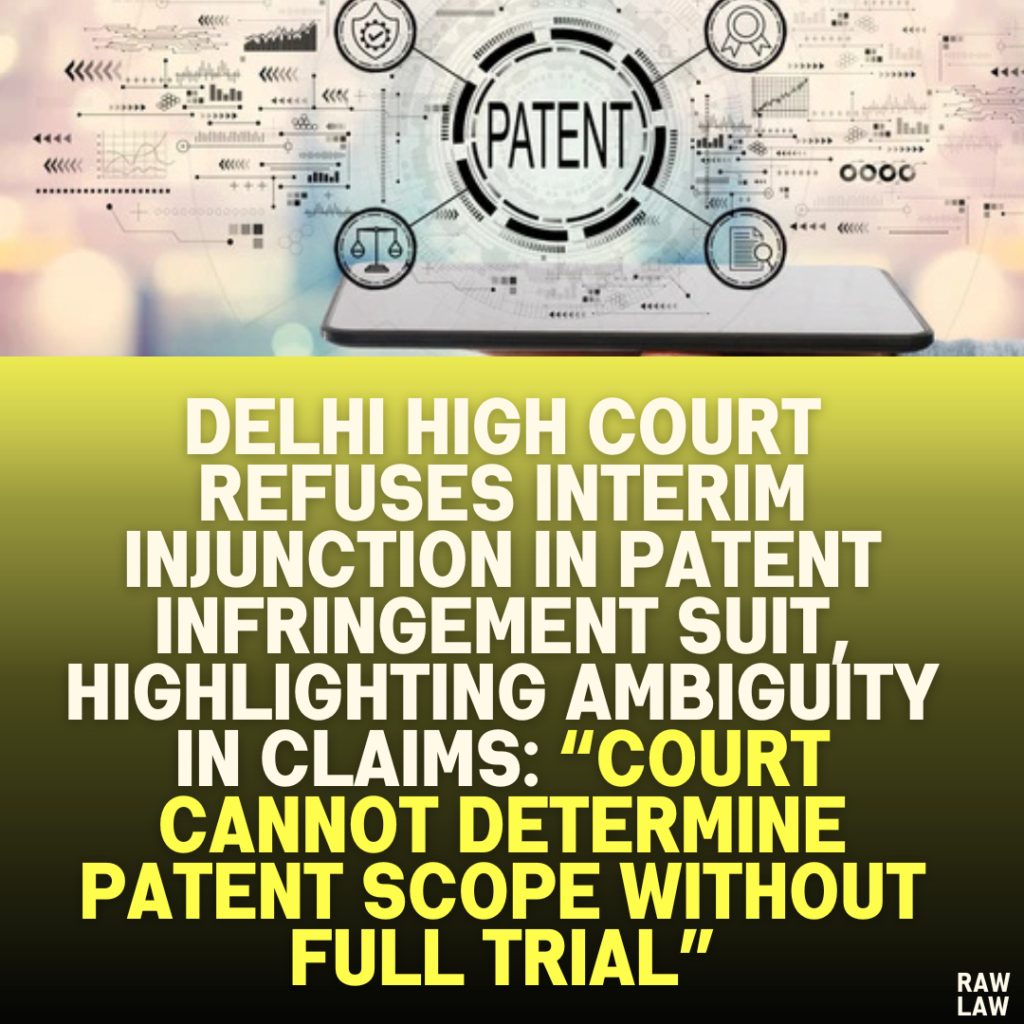1. Court’s Decision
The Delhi High Court dismissed the plaintiff’s application for an interim injunction, finding that the claims of the patent were ambiguous and required a full trial for conclusive determination. Justice Amit Bansal stated, “When the scope of claims itself is not clear, the court cannot conclusively determine the scope of the patent at the stage of consideration of application for an interim injunction.”
The court ruled in favor of the defendants, relieving them of their prior undertaking not to accept new orders for the allegedly infringing products. However, the court directed the defendants to maintain detailed accounts of the manufacture and sale of the impugned products.
2. Facts
- Background of the Patent:
- The plaintiff held Patent No. 427110, titled “Air Tight Fuel Cap,” granted on March 27, 2023.
- The patent aimed to maintain air pressure within a fuel tank and prevent spillage during vehicle movement.
- Discovery of Alleged Infringement:
- In March 2023, the plaintiff discovered that the defendants’ product (Model No. COML-13) was allegedly infringing their patent. The plaintiff purchased the product and sent it for expert analysis.
- The plaintiff claimed that the defendants had approached major customers, including the TATA Group, to market the impugned products.
- Legal Actions:
- The plaintiff filed a suit for permanent injunction against the defendants, alleging patent infringement.
- The defendants countered with claims of non-infringement and raised objections based on the patent’s ambiguity.
3. Issues
- How should the key terms in Claim 1 of the patent, such as “predetermined distance” and “main circular plate,” be interpreted?
- Does the defendants’ product infringe upon the plaintiff’s patent?
- Does the ambiguity in the claims preclude the grant of interim relief?
4. Petitioner’s Arguments
- The plaintiff argued that the defendant’s fuel cap infringed its patent by deploying an identical mechanism to maintain airtight sealing.
- The plaintiff interpreted the patent to include the engagement projections (EP) as part of the “main circular plate” (MCP) for measuring the “predetermined distance.” Under this interpretation, the defendants’ product would fall within the patent’s scope.
5. Respondent’s Arguments
- The defendants contended that the engagement projections (EP) and the main circular plate (MCP) were distinct components.
- They asserted that the “predetermined distance” in their product exceeded the defined range of 10%-100% of the MCP’s thickness, making it non-infringing.
- The defendants highlighted that the plaintiff’s interpretation contradicted the patent’s specification and prosecution history.
6. Analysis of the Law
- Claim Construction:
The court emphasized that interpreting patent claims is the cornerstone of infringement disputes. Claims must be read as ordinary sentences and understood based on their wording, specifications, and prosecution history.- As per Guala Closures SPA v. Agi Greenpac Ltd., the court reiterated that claim construction often resolves issues of infringement and validity.
- Claims cannot be rewritten or expanded post-grant, especially to suit litigation needs.
- Role of Numerical References:
The court analyzed the numerical references “241” (MCP) and “242” (EP) used in the patent. Claim 1 explicitly referenced “241” but excluded “242.” Claim 2, which mentioned both, did not specify the range for the “predetermined distance.”- The court held that these distinctions clarified that the MCP and EP were separate components.
- Prosecution History:
- During the patent’s prosecution, the plaintiff amended Claim 1 to include the term “l” (length), explicitly referring to the MCP. This amendment was made to address prior objections regarding the claim’s clarity.
- The court found that this history supported the defendants’ interpretation that the “predetermined distance” applied only to the MCP, excluding EP.
- Role of the MCP in the Patent:
The MCP was shown to play a significant functional role in the patent’s working, including housing and aligning components for airtight sealing. The court rejected the plaintiff’s argument that the MCP was a non-functional component.
7. Precedent Analysis
- Virgin Atlantic Airways Ltd. v. Premium Aircraft Interiors Group Ltd.: The court relied on this judgment to underline that numerical references in patent claims serve as aids but do not limit claim scope.
- Guala Closures SPA v. Agi Greenpac Ltd.: The court cited this case to stress the importance of balancing broad claims for infringement coverage with clarity to avoid invalidation due to prior art.
8. Court’s Reasoning
- The court found the plaintiff’s interpretation inconsistent with the patent’s wording, specifications, and prosecution history.
- It noted that ambiguities in the claims, especially concerning the MCP and EP, precluded a prima facie finding of infringement.
- The defendants’ measurements and structural differences convincingly demonstrated non-infringement based on the proper interpretation of Claim 1.
9. Conclusion
- The court dismissed the plaintiff’s application for interim injunction, finding no prima facie case for infringement. It held that the balance of convenience and potential irreparable harm favored the defendants.
- The defendants were relieved from their prior undertaking but were directed to maintain detailed records of their product sales.
10. Implications
- For Patent Drafting:
This case underscores the importance of drafting clear, unambiguous claims. Prosecution history and amendments play a pivotal role in litigation and may limit interpretations during enforcement. - For Patent Enforcement:
Ambiguities in patent claims can hinder enforcement, especially at preliminary stages. Plaintiffs must establish clear claim scope to secure interim relief. - For Market Participants:
The ruling emphasizes the need for defendants to meticulously document product design and distinguish it from existing patents to defend against infringement claims effectively.



